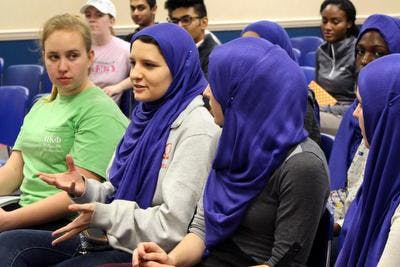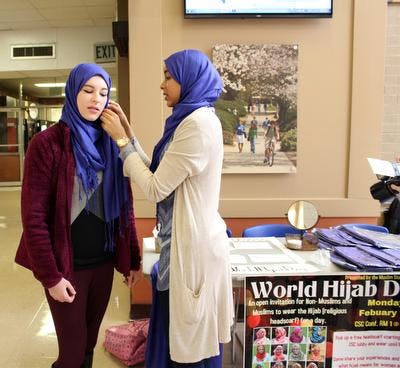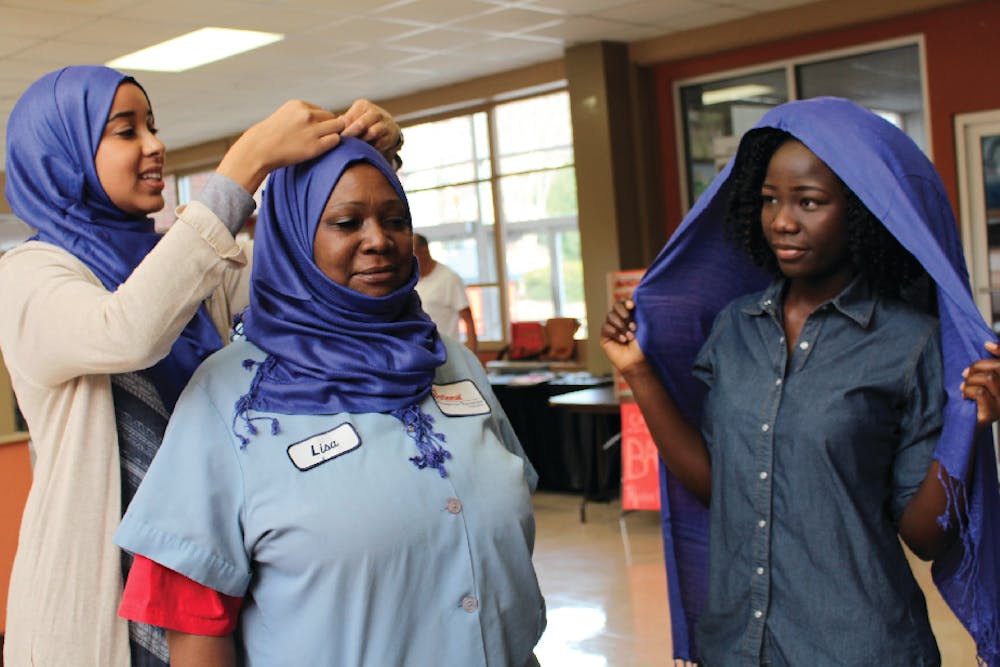The Muslim Student Association of Mercer University (MSA) hosted a “World Hijab Day” event Feb. 1 where all women — Muslim and non-Muslim — could participate in the wearing of a religious headscarf. The organization distributed new hijabs and taught Mercer students how to put them on.

Non-Muslim students explain their experience of wearing a hijab for a day during World Hijab Day on February 1.
The purpose of the annual worldwide event is to “foster religious tolerance and understanding,” according to the World Hijab Day website, and to invite all women to experience a part of the religion.
Hiba Yacout, president of MSA, said she hopes the event at Mercer educates students on the practices of Islam and lifts some of the negative stereotypes associated with wearing the hijab.
“We hope to allow other people to . . . be more educated about what hijab is and its purpose for Muslims,” Yacout said.
She said that wearing a hijab is a choice made by all women in the Islamic faith. The term does not simply refer to a head scarf, but it is a general word for modesty and the practitioner’s covenant with God.
At the end of the day, participants in the event gathered in the Connell Student Center to talk about their experiences with hijab-wearing. The presentation included Mariyum Kahn, a junior who chooses to wear hijab regularly; Hoor Qureshi, a freshman who chooses to not wear Hijab; and Basil Alrafatl, who spoke on modesty practices for men in the Islamic religion.
“To me, hijab is a sign of modesty, empowerment, beauty and hidden beauty,” Kahn said in her speech.
The talk also focused on the perceptions of Muslims in America and how hijab-wearing women both confront and expel these stereotypes.
[pullquote speaker="Mariyum Kahn" photo="" align="left" background="on" border="all" shadow="on"]Politics, news, media, social media. Things are always out there targeting Muslims and especially girls that wear hijab because we are an automatic sign.[/pullquote]
“Politics, news, media, social media. Things are always out there targeting Muslims and especially girls that wear hijab because we are an automatic sign. But if people are staring at me, I just smile at them,” Kahn said.
All three speakers emphasized the women’s choice to wear a hijab and addressed the misconception that women who wear the headscarf are oppressed by men. Alrafatl said that while men don’t have to wear a hijab, they are expected to cover the area from their navel to their mid-thigh and must have their shoulders covered during prayer.
The practice of hijab is also reflected in the way Muslims present themselves and their lifestyle of modesty.
“Hijab is also your character, the way you carry yourself, acting in a way that is modest and in a way that Islam should be,” Alrafatl said.
Similarly, Qureshi said that the practice of not wearing a hijab does not undermine the validity of one’s faith if their lifestyle is in keeping with Islamic custom.
“Those who don't wear a hijab, that doesn't make you less of a Muslim. Your definition is only important to God,” Qureshi said.
Participants in the event were encouraged to speak about their experiences of the day and to share with the group any feelings they had during the process.

Hiba Yacout, President of the Muslim Student Association, helped a student put on a hijab.
Most women who participated in the event said they were hesitant at first but slowly became more comfortable with how they looked wearing the bright blue Hijab provided by MSA.
Others reflected on the varied stares and whispers they received during the day and disclosed how close friends had trouble recognizing them.
“I personally found that people who know me had more of a reaction than anyone else. They would be the ones to say, ‘Oh I didn't recognize you’ and ask me what’s going on,” said Brooke Barker, a non-Muslim participant. “I honestly felt like more people averted their eyes than to actually look at me. They felt like they weren't supposed to.”
Even if they faced strange reactions from their peers, many participants in the event said that they were happy to share in the religious and cultural experience of hijab-wearing. Barker spoke of her time with the hijab as educational.
“I feel like the best way to understand something like this is to experience it and wear it and see how a day in a woman’s shoes is when she is wearing a hijab,” Barker said.





